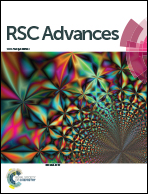Reversible hydrogen-bond-selective phase transfer directed towards noble metal nanoparticles and its catalytic application†
Abstract
Reversible phase transfer of noble metal nanoparticles (NMNPs) without the presence of phase transfer agents or supplementary reagents is a big challenge. Through a simple protocol, we demonstrated and expanded an easy, highly efficient, and continuously reversible hydrogen-bond-selective phase transfer directed towards thermoregulated ligand Ph2P(CH2CH2O)22CH3-stabilized noble metal (Pt, Ru, Ir, Pd, and Au) nanoparticles in the aqueous/alcohols biphasic system. When the thermoregulated ligand was integrated onto the NMNP surface, it provided a better switchable surface hydrophobicity/hydrophilicity for the NMNPs. So the critical parameters controlling the phase transfer of NMNPs, such as temperature, gas atmosphere and organic solvent, were studied. With the help of TEM, UV-vis, and ICP-AES, the as-prepared NMNPs (Pt, Ru, Ir, Pd, and Au) not only exhibited a high level of dispersion stability, but also had an almost constant size distribution (excluding Au-NPs) and very high phase transfer efficiency during the multiple reversible phase transfer processes. In addition, a simple mechanism with respect to the reason for the increase of Au nanoparticle size was discussed. Subsequently, the as-prepared Pt-NPs were used as the catalyst for the hydrogenation of diphenylacetylene (DPA). A complete semihydrogenation to stilbene and a better stereoselectivity to cis-stilbene were achieved. Additionally, the as-prepared Pt-NPs can be recycled for 13 times without evident loss in activity and selectivity. Therefore, our investigations supply a fundamental and systematic study of the reversible phase transfer of NMNPs (Pt, Ru, Ir, Pd, and Au), and then also afford an attractive solution to the problem of separating and recycling the NMNP catalysts.


 Please wait while we load your content...
Please wait while we load your content...